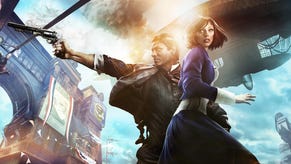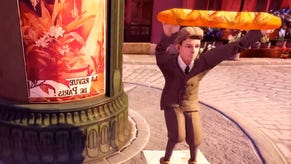BioShock Infinite
Frontierland.
I can't think of BioShock without thinking of Walt Disney. Aside from Andrew Ryan sporting the same haircut and moustache as the famous animator, both were perfectionist visionaries who would do whatever it took to create their own paradise. One built an underwater city, while the other was in the process of doing the same in a Florida swamp before he died. Disney may not have lived to see his dream come to fruition, but he at least left behind a hell of an amusement park, whereas Andrew Ryan's legacy was a rotting tomb at the bottom of the sea.
It's only fitting then that Irrational Games' follow up, BioShock Infinite, bears a resemblance to the Magic Kingdom. Its floating city of Columbia's quaint architecture is comprised of cobblestone roads, well groomed grass and pastel storefronts bringing to mind Main Street U.S.A., while the giant manors floating in the clouds resemble a cross between the Haunted Mansion and Snow White's castle.
The cultural and political turmoil that defined BioShock has returned - this time focusing on pompous nationalism, workers rights, and scientific pursuits of this alternate early 20th century - but whereas before the allegories and setting were thrust into the foreground, BioShock Infinite uses them as a backdrop for a character driven story.
"We've always been successful about immersing people in a space," BioShock creator Ken Levine says. "Now we want to immerse them in a relationship."
Before unveiling a new 15 minute hands-off demo at the Viceroy hotel in Los Angeles, Levine sets the stage: the player assumes the role of former Pinkerton agent Booker Dewitt, a man with a troubled past and gambling debts. He's given an offer he can't refuse by a mysterious benefactor who tasks him with flying to the floating city of Columbia and bringing a girl named Elizabeth back to New York.

Columbia was something of a travelling American emissary, a means of presenting its power unto the rest of the world. After it was involved in an international incident involving the destruction of a city in China during the Boxer rebellion, it seceded from the United States and became its own sovereign nation. Complicating matters, Elizabeth has mysterious powers and has been held prisoner in a tower since she was five years old.
As luck would have it she's also the key to a civil war within Columbia. The Founders, a group of ultra-nationalist religious fundamentalists, want her to stay in the tower, while the internationalist anarchist movement, Vox Populi, want her dead. Busting her out instigates the war, and places you firmly at its centre.
The demo begins with DeWitt and Elizabeth setting off in search of a man named Z.H. Comstock. He's the leader of the Founders, and the only person that can help Elizabeth control her powers.
BioShock Infinite's focus on characters is apparent from the off. DeWitt and Elizabeth enter the Columbia Flag Company, a touristy storefront. Filled with American flags and nationalist memorabilia, Elizabeth playfully throws on a Lincoln mask and begins to recite the Gettysburg Address. While her childlike naiveté kicks in (she mistakes cheap trinkets for solid gold) Dewitt is preoccupied with looting more practical things like cash, a pistol, and a Bucking Broncos Vigor, this iteration's equivalent to plasmids.










.png?width=291&height=164&fit=crop&quality=80&format=jpg&auto=webp)




.jpg?width=291&height=164&fit=crop&quality=80&format=jpg&auto=webp)
